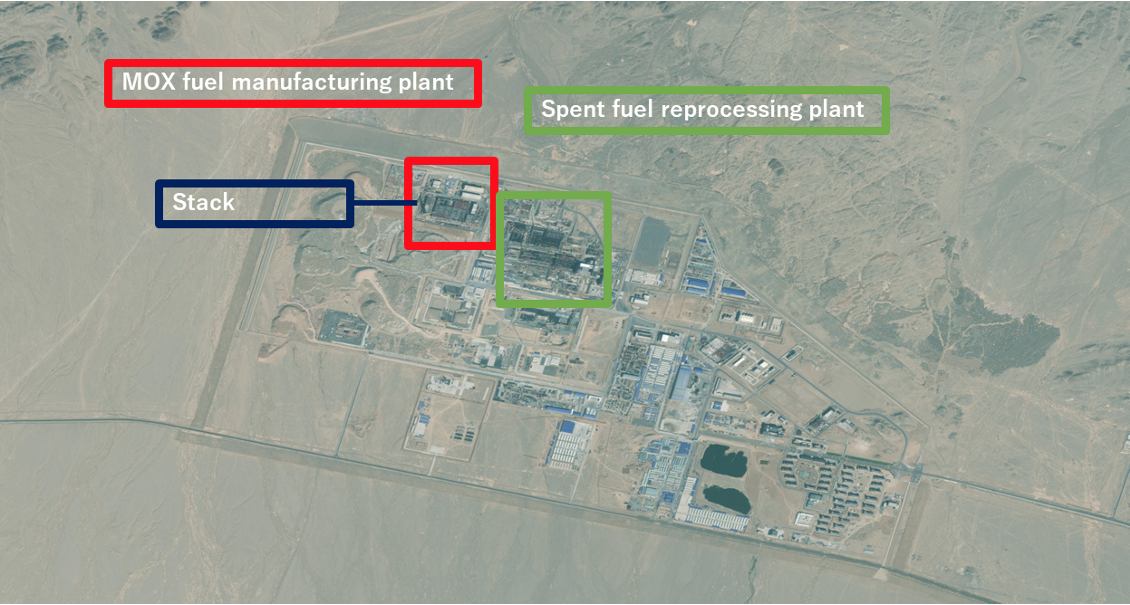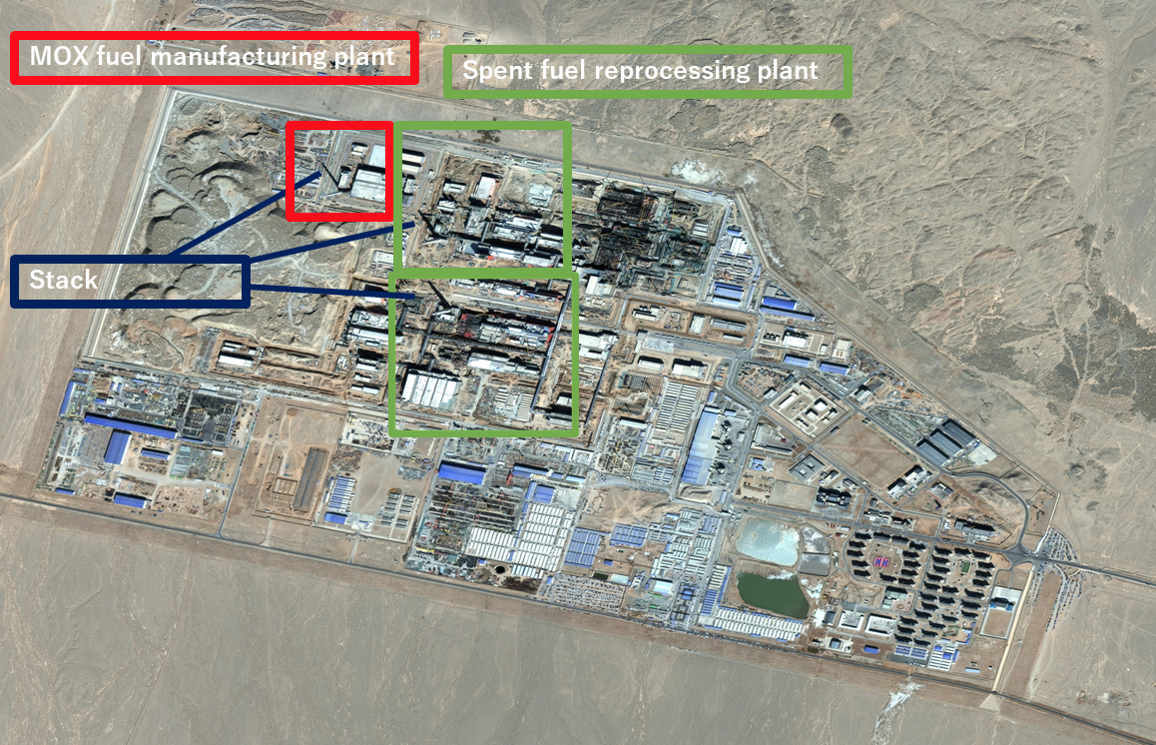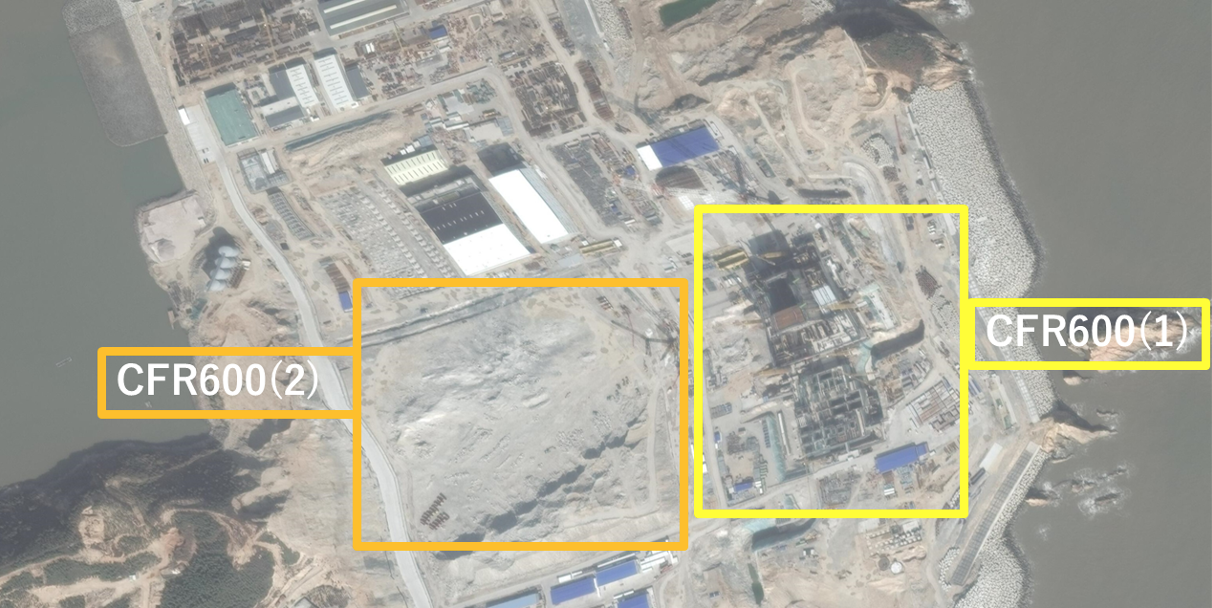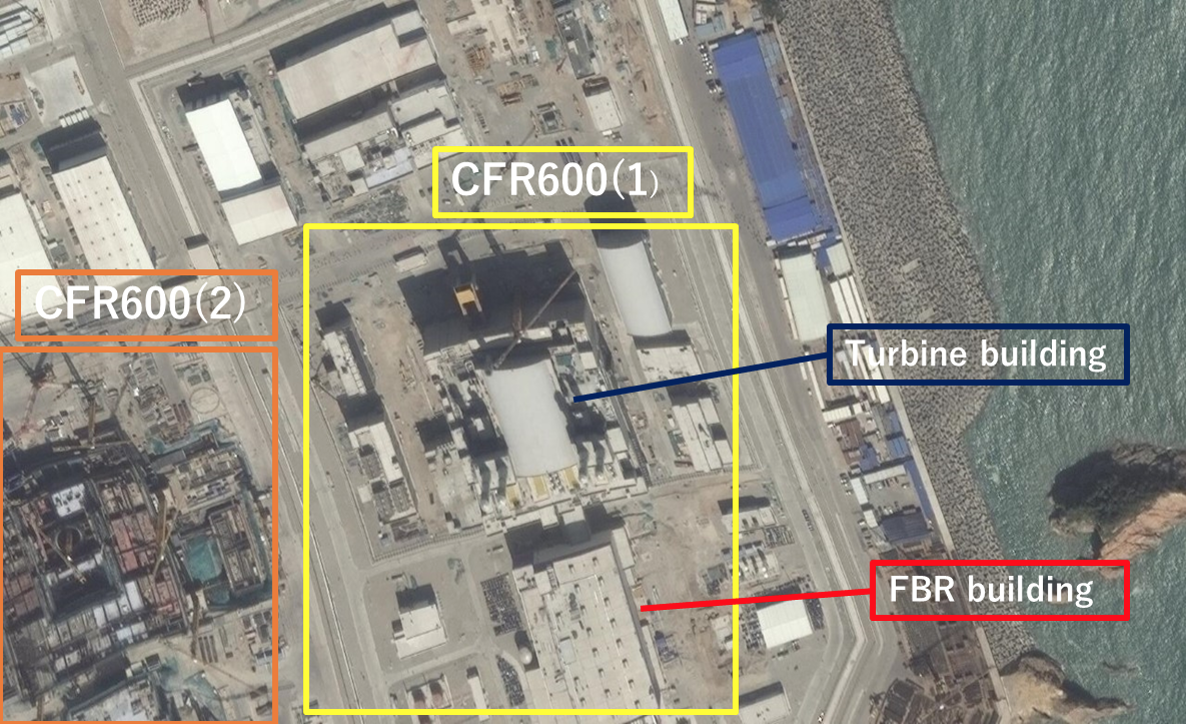Satellite Imagery Analysis 2023/02/14
China’s Plutonium Production and Nuclear Arms Expansion
Yuki Kobayashi (Research Fellow, Sasakawa Peace Foundation)
China’s expansion of its nuclear arms is becoming full-scale, aiming at parity in military power with the US. The 2020 version of “Military and Security Developments Involving the People’s Republic of China,” a report on military trends in China which the US Department of Defense submits to Congress each year, pointed out that “Over the next decade, China’s nuclear warhead stockpile—currently estimated to be in the low-200s—is projected to at least double in size.”[1] The 2021 version of this report further predicted that “The PRC likely intends to have at least 1,000 warheads by 2030, exceeding the pace and size the DoD projected in 2020.”[2]
China’s increased production of plutonium for civilian use (power generation) and its alleged attempts to secretly divert this to military use may be cited as background as to why the US raised its projection and revealed its alarm about China’s expansion of nuclear weapons. Specifically, this includes China’s plans to build nuclear fuel reprocessing facilities to separate plutonium from spent fuel from nuclear power plants, mix plutonium with uranium to produce mixed oxide fuel (MOX fuel), and use it in fast breeder reactors (FBRs). This is because FBRs make it possible to extract ultrahigh-purity plutonium 239, which can be diverted to nuclear weapons, through fuel reprocessing. Possibly because of these circumstances, at the Non-Proliferation Treaty (NPT) Review Conference held at the UN Headquarters in New York in August 2022, China strongly opposed the proposal to halt the production of fissile material, which was expected to have the effect of restricting further expansion of nuclear weapons. Such movements by China are examined in my paper “Observations on Lack of Transparency in China’s Nuclear Arms Expansion: Ahead of the NPT Review Conference.”[3]
This time, I attempt to substantiate China’s movement toward nuclear arms expansion by analyzing satellite images of sites where construction of nuclear fuel reprocessing facilities and FBRs is proceeding obtained by the Sasakawa Peace Foundation’s China Observer.
China began the construction of two reprocessing plants in the desert in Kansu Province from 2015. While the Chinese government and the China National Nuclear Corporation (CNNC), which is the operating company, have not revealed any details of these reprocessing plants, Plant 1 is expected to begin operations from around 2025 and Plant 2 from around 2030.
The following satellite images show the nuclear fuel reprocessing plants construction site on October 7, 2019 (Satellite Image 1) and the same site on February 28, 2022 (Satellite Image 2).

Satellite Image 1

Satellite Image 2
The reprocessing facilities which extract plutonium from spent fuel used in conventional nuclear reactors are marked with green squares and the MOX fuel plant which mixes the extracted plutonium with uranium is marked with a red square. While this may be a bit difficult to see in Satellite Image 1, which was taken from some distance, in Satellite Image 2, Plant 1 (below) and Plant 2 in the reprocessing facilities can be distinguished.
Comparing the two images, one can clearly see that the construction has advanced over the three years. Tomonori Iwamoto, Secretary General of the Institute of Nuclear Materials Management (INMM) Japan Chapter notes that a white tower (stack) protrudes from Plant 1 and Plant 2 respectively in Satellite Image 2. These are marked with blue lines on the images, and their long shadows are clearly shown, demonstrating that these structures are substantially high. These are facilities for the shearing and dissolving of spent fuel in the first process of extracting plutonium from spent fuel, and because minute quantities of radioactive gas are generated in that process, they are discharged from the stacks. According to Iwamoto, the reprocessing of spent fuel passes through the following four processes.
(1) Shearing and dissolving: The spent fuel is broken down into small pieces and immersed in nitric acid.
(2) Separation: The uranium, plutonium, and other fission products that have been dissolved in nitric acid are separated.
(3) Refining: The uranium and plutonium are each refined.
(4) Productization: The uranium and plutonium are powdered and made into a form that is suitable for MOX fuel fabrication.
The nuclear fuel reprocessing facility at Rokkasho Village, Aomori Prefecture in Japan has already cleared all of the above processes in trial operations. However, after productization, problems emerged in the vitrification process of mixing highly radioactive liquid waste generated in the reprocessing process with glass raw materials for final disposal. Operations were delayed because it took time to resolve this and because new safety measures works became necessary after the 2011 disaster at the Fukushima Daiichi Nuclear Power Plant.
Satellite Image 2 shows that at the Kansu Province site, the facilities for process (1) have been completed at both Plant 1 and Plant 2, and further that the foundation construction for the other processes has been completed at Plant 1, which has reached the stage of carrying in equipment. Based on such facts, Iwamoto notes that “there is a high possibility that at least Plant 1 will begin operations within a few years.”
FBRs which are expected to use the plutonium generated from the reprocessing plants “produce” new plutonium from the nuclear fuel reaction during operations, enabling the recovery of more plutonium than the amount that is input, so they are known as “dream nuclear reactors.”[4] Japan led technological development toward the commercialization of FBRs together with the US and France, and was operating the “Monju” FBR. However, there are difficulties with the control of the sodium used to cool the reactor, and at present the development of FBRs has been ceased or suspended aside from Russia and China. China is constructing two large FBRs called CFR600 near the coast in Fujian Province, which are scheduled to begin operations in around 2023 and 2026 respectively.
The following photographs are satellite images of the FBRs construction site. Satellite Image 3 was taken on January 30, 2020 and Satellite Image 4 was taken on September 30, 2022.

Satellite Image 3

Satellite Image 4
Both of these images are somewhat distorted, but the construction progress status can be clearly confirmed. In Satellite Image 3 even the foundation for the construction of CFR600(2) is not completed, but Satellite Image 4 shows that the foundation works have advanced. Regarding CFR600(1), Satellite Image 4 shows that the construction of two large facilities is nearly completed. Based on their shape, Iwamoto explains that the building marked with a red line is the building containing the FBR and that the building marked with a blue line is the turbine building which produces power by spinning a turbine using steam generated by the reactor heat. Iwamoto says that CFR600(1) is nearly completed, including its other facilities, and analyzes that the “start of operations will be possible within fiscal 2023.”
If FBR development succeeds, the ability to produce the plutonium necessary for expanding nuclear arms will dramatically increase. Looking back at the history of nuclear development in each country, graphite reactors were used to produce plutonium for use in nuclear weapons during the early days of nuclear power use in the advanced nations and these are still used today in countries with inferior technological capabilities. Graphite reactors can use natural uranium for fuel as it is, without the trouble of manufacturing fuel, and plutonium can easily be extracted through reprocessing. On the other hand, the amount of plutonium included in the spent fuel is minimal at around one gram per spent fuel rod, so producing weapons-grade plutonium requires replacing a lot of fuel many times over and burning the fuel. Graphite reactors are being used in North Korea’s nuclear development.
In contrast, with FBRs, new plutonium is generated from uranium fuel (blanket fuel) around plutonium during the period of half a year to one year when plutonium fuel is burned to generate power. When FBRs are used purely for power generation, the newly produced plutonium is also used as fuel. However, if this blanket fuel is removed and reprocessed when it changes into plutonium, high-purity plutonium 239 that is suitable for weapons applications can be obtained in large quantities.
If the CFR600 (two reactors) begins operations as scheduled from now, projections indicate that a maximum of more than 330 kilograms of weapons-grade plutonium could be acquired per year and that China could have a cumulative total of 2.9 ±0.6 tons of weapons-grade plutonium by the end of 2030. This estimated quantity is equivalent to 830 ±210 nuclear warheads. This indicates that the US Department of Defense analysis that “the PRC likely intends to have at least 1,000 warheads by 2030” is consistent with the projected increases in China’s future plutonium production.
Japan is the only non-nuclear-weapon state authorized to extract plutonium at nuclear fuel cycle facilities and reuse this in FBRs. This is because as the only country in the world that has been atomic bombed in a war, Japan is recognized to have cooperated fully with the International Atomic Energy Agency (IAEA) and contributed earnestly to the compatibility of nuclear nonproliferation and civilian use of nuclear energy in terms of the use of nuclear materials that could be converted to military purposes. As a neighboring country, Japan is in a position to appeal to China not to divert such civilian-use technology to military use without reporting to the IAEA. It is necessary to continue with analyses making use of satellite imaging technology and verifications of China’s use of reprocessing facilities and FBRs.
1 Office of the Secretary of Defense, “Military and Security Developments Involving the People’s Republic of China 2020”, p. ix.
2 Office of the Secretary of Defense, “MILITARY AND SECURITY DEVELOPMENTS INVOLVING THE PEOPLE’S REPUBLIC OF CHINA 2021”, p. viii.
3 Kobayashi, Yuki, “Observations on Lack of Transparency in China’s Nuclear Arms Expansion: Ahead of the NPT Review Conference”.
4 “‘Yume no Genshiro’ Monju Shōmetsu de Shikichi Katasumi ni Shin Kenkyūro: Jimoto wa Ondosa” [New Research Reactor at the Corner of the Grounds with the Demise of the “Dream Reactor” Monju: Local Reaction Varies], Mainichi Shimbun, April 30, 2022.





